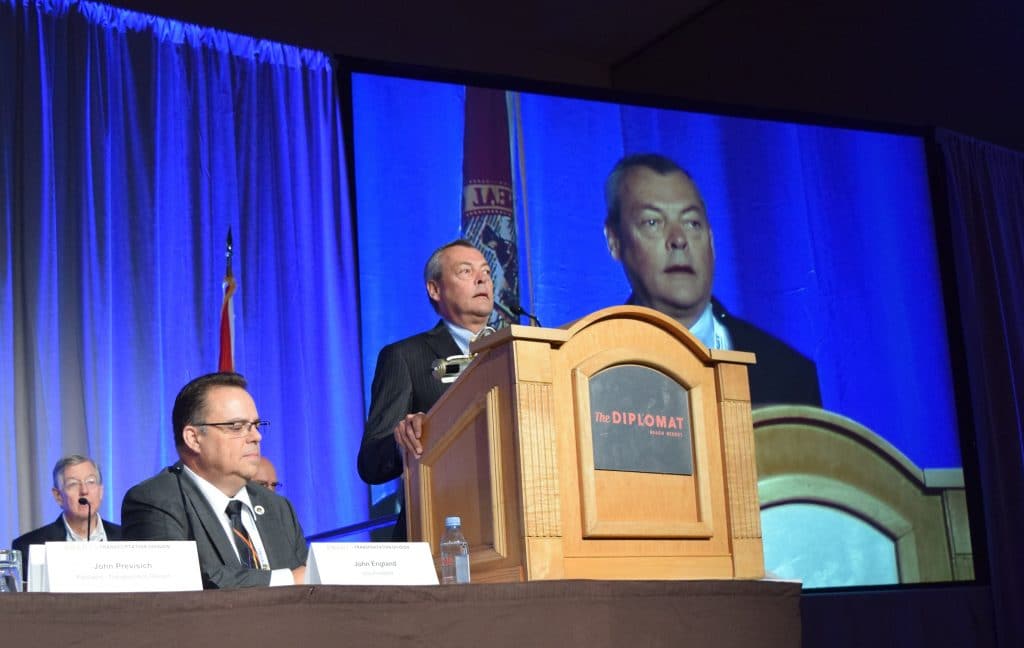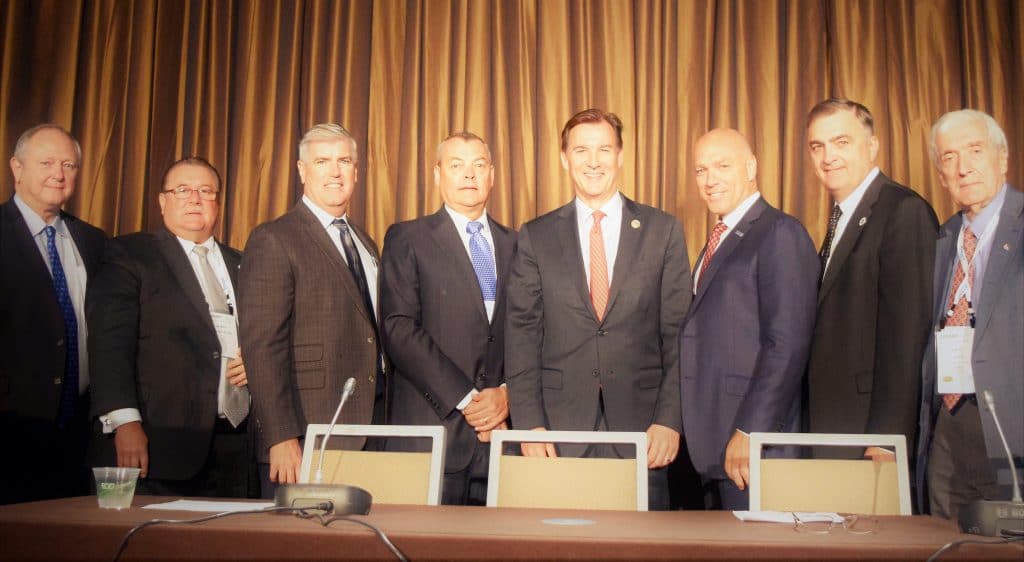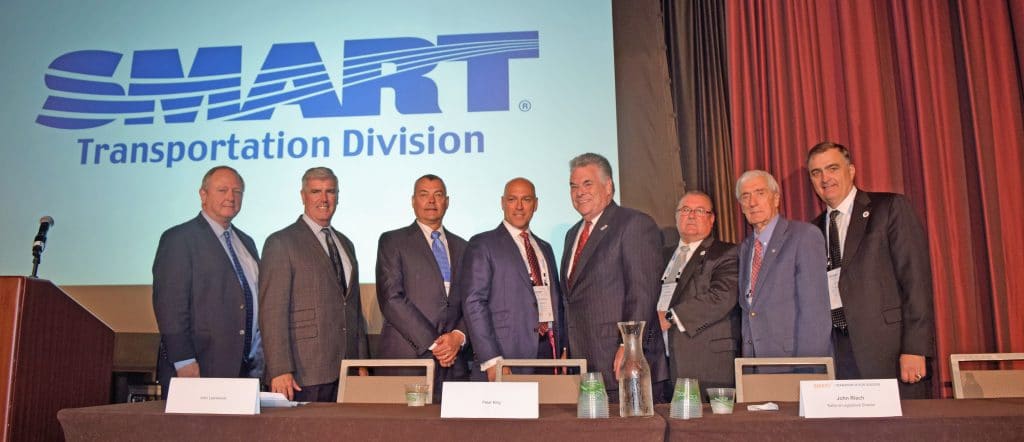HOLLYWOOD, Fla. — Transportation Division President John Previsich looked to the recent past to point the way to the future on Monday, Aug. 6, at a critical point in United States labor history.
In opening remarks to the International Association of Sheet Metal, Air, Rail and Transportation Workers’ first combined educational meeting at the Hilton Diplomat Resort in Hollywood, Florida, Previsich reflected on the status of the coordinated bargaining unit’s national rail agreement talks that appeared to be at a standstill last summer and an appearance at the Sheet Metal Business Agents Conference in Vancouver last year that he said might have changed the tide.
At the time, a declaration of an impasse was likely at the next meeting between the rail labor unions and the carriers and a Presidential Emergency Board would convene, Previsich said.
But the potential impasse was broken at the next meeting with the carriers willing to negotiate, and Previsich has an inkling of what played a big part: unity.
“I told the Sheet Metal brothers and sisters in the room that when the time came, and that we had to look at a Presidential Emergency Board, I said I didn’t want 65,000 Transportation Division members calling the White House, I wanted 200,000 SMART members calling the White House,” Previsich said. “Every brother and sister stood up and pledged their support. I would like to think that support, that word, that message, got – maybe to the White House. It got somewhere good, because at the very next session immediately after that meeting in Vancouver, the railroads came into the room and started negotiating.”
Within a month, a contract offer was on the table that was ratified Dec. 1, 2017, by four out of five TD members, Previsich said.
“It was the support of everyone in that room that made that happen,” he said.
Establishing that unity not only within SMART but among all labor organizations nationwide and education efforts will be key in the aftermath of the attack on labor in the form of this summer’s Janus decision by the U.S. Supreme Court, Previsich said.
“There are forces out there that want to reset the entire playing field. They want to move the goalposts to a place that we can’t get to. They started with Janus,” he said.
The Janus decision nullifies the ability of public-sector unions to collect what are known as maintenance fees from “free-riders” — those people who take advantage of union membership benefits but do not pay for those benefits.
“It’s not going to be fatal to our organization, but it will be close to fatal to other organizations,” Previsich said.
Teachers unions, the SEIU and unions that protect government employees will be most affected, but that doesn’t mean that those anti-union forces will stop at just that single victory to crush labor in the U.S., he said.
“The next step is to private employers and there are already efforts to start that happening,” Previsich said. “They create a dispute here, a dispute there, get some conflicting court decisions and boom, it bubbles up to the Supreme Court.”
With a second Supreme Court vacancy to be filled by the Trump administration, 150 years of labor history that workers fought and died for is under attack and in jeopardy in the United States, Previsich said.
Union members need to act.
“We can no longer sit back and let somebody else take care of our business. We have to take care of it,” Previsich said. “We have to stand united, not only within, but with every other labor organization in the country. We need to talk to our friends, our relatives, our neighbors and everybody we encounter in the grocery store and let them know the labor movement is an honorable movement.
“It’s the foundation of America, and if they start beating back the unions, they’re going to beat back every employee in any form whether they’re unionized or not … we can’t let it happen.”
The key to stopping the attack will be individual action and spreading the word, member-to-member, about the importance of the November mid-term elections, Previsich said.
“This is really the cliff-side point in labor history. I can’t stress strongly enough how important it is that we get out there and motivate our members to get out there to preserve the labor movement,” he said. “We can’t forget our paychecks. We can’t forget our pensions, our benefits and our families.
“We need to make sure our members are educated on everything that is important to the cause, the movement, the preservation of the labor lifestyle that comes about as the result of unions and the hard work that they’ve been doing for 150 years.”
Earlier in the opening session, SMART General President Joseph Sellers Jr. and General Secretary-Treasurer Rich McClees also encouraged the further development of solidarity by increasing cooperation between the Sheet Metal and Transportation Division membership.
The Hollywood, Fla., combined educational meeting itself marks the first time since the Sheet Metal and Transportation Division’s merger that both a TD regional meeting and a Sheet Metal business agents conference have taken place at the same location.
Tag: John Previsich
On Monday, July 10, 2017, U.S. Congressmen from the State of New York, Rep. Tom Suozzi (D) and Rep. Peter King (R), addressed SMART TD members and officers at the Eastern Regional Meeting in New York City, Suozzi at the morning opening session and King at the lunch reception.
Although new to Congress, Suozzi served for many years as mayor of his hometown and later as a county representative, with a long-time focus on working families and labor issues.
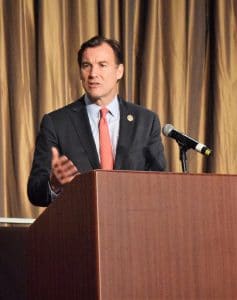
“The transportation industry, your industry, built America. The American dream is slipping away and too many working families have been left behind, but there is hope,” Suozzi said.
“How can we rebuild a strong, vibrant middle class? The hope is reflected in this room, in the power of strength in numbers, organizing and working together to move our infrastructure forward, create new jobs and maintain a strong union base, that is how,” Suozzi said.
At the lunch reception, Republican Congressman Peter King, who represents the Long Island, N.Y. region, vowed that his longtime advocacy of transit and rail labor issues, including his staunch support of minimum two-person crew mandates, will not wavier.
“I am proud to stand with you. I will do everything in my power to work with labor to get the job done, to protect your jobs and to protect your interests,” King said.
He added that transportation, including bus, rail and air, remains at the heart of the economy, and the hope for the future of working men and women.
“I will continue to work with SMART TD, with labor leaders and with elected officials on both sides of the aisle, to move America’s infrastructure upgrades forward, and to work together to protect and grow our nation’s transportation jobs. SMART TD is stronger than ever, and together, we will make sure that our jobs are protected,” King said.
SMART TD honors Representative King with Brass Lantern Award
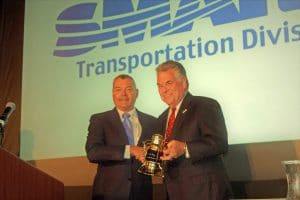
At the closing of the lunch reception, John Previsich, SMART TD president, presented Rep. King with the coveted Brass Lantern Award, on behalf of SMART TD.
“The Brass Lantern is not awarded often, and is presented to those rare individuals who have never waivered in their commitment to the issues and concerns of our membership. We are pleased to recognize Congressman Peter King as a recipient of the Brass Lantern Award, that recognizes his efforts, and we look forward to our continued partnership,” Previsich said.
Transportation union leaders vowed to “redouble their efforts” to push for bipartisan solutions to the growing transportation infrastructure investment crisis that is undermining the economy and idling millions of jobs, said AFL-CIO Transportation Trades Department President Edward Wytkind following the 2014 Fall TTD Executive Committee meeting Nov. 13.
“We had an important conversation today about how the midterm elections will impact our members in 2015,” Wytkind said. “We focused on how we can change the tone and content of the senseless debates in Washington about the bread and butter economic issues that have gone unaddressed for too long. We also vowed to stop current and newly elected members of Congress who think they’re being sent to Washington to eviscerate workers’ rights and abdicate the federal government’s responsibility as the chief steward of our transportation system.”
SMART Transportation Division President John Previsich and SMART Transportation Division National Legislative Director John Risch were in attendance.
Sen. Tom Carper (D-Del.) joined the meeting to collaborate with transportation unions on strategies to end the gridlock on vital transportation funding legislation. Specifically, Carper emphasized the need to stop “kicking the can” on a long-term fix to the insolvency faced by the Highway Trust Fund, which is the centerpiece of transit, highway, and bridge investments.
“I am committed to working with TTD affiliates, as well as a broad coalition of businesses, labor, truckers, motorists, transit riders, and elected officials, to ensure Congress does its job to pass and fund a long-term transportation bill. Without long-term funding certainty, our cities and states have put projects on hold that would repair our aging infrastructure and grow our economy,” Carper told transportation union leaders.
“Passing a fully-funded surface transportation bill is my top priority in the lame duck session, but Congress also must not lose sight of other critical infrastructure responsibilities in the rail, aviation, and port-maritime sectors. I believe that the chorus of voices supporting this initiative will be heard and Congress will do the right thing.”
Two senior officials of the Obama administration also joined the meeting to discuss the president’s goal to boost investments in and modernize our transportation system.
Byron Auguste, deputy director of the National Economic Council, and Peter Rogoff, undersecretary of transportation for policy at the U.S. Department of Transportation, joined the Executive Committee to discuss strategies to unify Democrats, Republicans, and Independents around a bipartisan solution to our severe infrastructure investment deficit and to emphasize the importance of such a solution to the administration in 2015.

The inquiry relates to a proposed collective bargaining agreement between SMART Transportation Division GO-001 and BNSF Railway and is in regard to crew consist for its affected members.
The text of the letter follows.
“Mr. Andres Trujillo, Chairman
National Association of State Directors
“Dear Sir and Brother:
“This is in response to your letter of August 5, 2014, wherein you request an interpretation related to the role of the legislative department in connection with the collective bargaining jurisdiction of our General Committees. Your inquiry stems from questions in connection with a collective bargaining agreement proposed by GO-001 regarding crew consist for its affected members. A number of issues have been raised in connection with that agreement and this response to your inquiry will include clarification of those issues so that all concerned will be fully informed on this matter.
“To begin, the issue of a General Committee’s right to negotiate crew consist for its members is a matter long settled. Our constitution grants the General Committees jurisdiction in this area and this organization has successfully defended that right over the years through litigation and arbitration (see, e.g., United Transp. Union v. Alton & S. Ry. Co., Case No.: 05-190-GPM, 2006 WL 664181 (S.D. Ill. March 10, 2006)). There are no grounds for any entity to interfere with that right and there will be no attack on that authority by this office or any subordinate body of this organization. Nonetheless, it should surprise no one that the proposed agreement is generating a great deal of discussion due to its potential impact beyond its own territory. This office will not interfere with the rights of all of our members to engage in that discussion.
“Next, a question has been raised with respect to the knowledge of the Transportation Division regarding the proposed agreement. Earlier this year, the officers of GO-001 requested a meeting to discuss “a matter of great importance to the committee and its members.” At the meeting this office was informed that GO-001 was negotiating an agreement that may include a provision for engineer-only operation under certain conditions. Included in that meeting was a discussion of general committee autonomy and authority to make crew consist agreements. An actual quote by one of the officers is “I have a file cabinet full of precedent that crew consist is a General Committee issue.” There was a great deal of discussion over the wisdom of making such an agreement and the affect that it would have nationally on other properties and on our legislative effort to require two certified people on every train.
“Some number of months later another meeting was requested, this time to inform this office of the content of the proposed agreement. Again, the wisdom and difficulties of such a proposal were discussed and it was stated by the undersigned that “if a committee is forced to submit to single person operations this outcome isn’t too bad.” In addition, some small errors were noted for correction. The key component of the statement above is “If a committee is forced to submit to single person operations.” Any assertion that such a statement constitutes an endorsement of the agreement is, at best, deliberately misleading and, in fact, the officers in the meeting were told in no uncertain terms that the agreement was in conflict with our national agenda and would not be endorsed by this office.
“Although the proposed agreement is clearly within the authority of the officers of GO-001 to negotiate, there is no doubt that passage of such an agreement would alter our dialogue in the legislative arena. As you are aware, efforts to preserve jobs and safety currently in progress are far reaching and not confined to H.R. 3040. The role of the legislative department is unchanged – we are working in every regulatory and legislative arena to protect our members and the public from the danger of single person operations and those efforts will continue.
“It is worth noting here that all General Committees with crew consist agreements will face expiring moratoriums at some point in the future. It is also important to note that an expired moratorium is where negotiations begin – once expired, notices must be served by the parties to enter into negotiations in accordance with the Railway Labor Act (this is intended to clarify any misinformation that would suggest to the listener that conductors are automatically removed from the train when a moratorium expires).
“Some will say that it is better to act earlier and get something at the cost of current jobs and others will argue it is better to wait while preserving current jobs for some time into the future, allowing legislative, regulatory and safety considerations to play out in the intervening time. Regarding the current proposal, it is up to the members of GO-001 to decide if now is the time for their committee to address single person operations.”

Amtrak links the Hudson Valley to the rest of North America. From Hudson and Albany, you can take the train to western New York, to New York City and to Canada. And people do just that: Last year, Amtrak’s Empire Service alone brought more than a million riders through the Hudson Valley, carrying business travelers and vacationers alike. A recent poll suggests that residents of the North Hudson Valley and the Catskills want to keep it this way. Like Americans throughout a wide cross-section of the nation, residents of the 19th Congressional District want more, and safer, Amtrak service.
According to the poll prepared by Dean Mitchell of DFM Research in Minnesota on behalf of the Transportation Division of the Sheet Metal, Air, Rail, and Transportation Union (formerly the United Transportation Union), 87 percent of residents would like to see daily passenger rail service increase or remain the same. This support cuts across party lines: More than 80 percent of residents like the idea of additional train service to cities like Boston, Buffalo and Chicago, including 75 percent of self-identified conservatives.

In a time of partisan gridlock and ideological polarization, these numbers are striking. With Congress preparing to rewrite the law that governs Amtrak — which carries more than 30 million passengers each year — elected officials should listen to their constituents and support one of the nation’s most important transportation resources.
A thriving Empire Service doesn’t come for free, but not only do North Hudson Valley residents want Amtrak to stick around — they’re willing to pay for it. Nearly 75 percent of residents, including almost 7 out of 10 Republicans, support funding at the current level or greater, even when told that the federal government subsidizes Amtrak by more than $1 billion per year.
Many of the rail lines used by Amtrak are shared by freight trains, and residents of the Hudson Valley also want to ensure that the rails passing by their towns and homes are safe. One idea that is wildly unpopular in the Hudson Valley is the use of one-person train crews, an unsafe practice that received attention last year when a train operated by a single crew member leveled a town just outside Quebec and killed 47 people. An overwhelming 84 percent of Hudson Valley residents would vote in favor of proposed legislation requiring two-person crews on freight trains, including almost 8 out of 10 Republicans. These numbers are similar to the results of polls around the country, reflecting a strong nonpartisan desire to prioritize safety.
Given the broad public backing for more Amtrak service and two-person crews on freight trains, one might think that congressional approval of expanded passenger rail and increased safety measures was a foregone conclusion. But many other common-sense transportation proposals have languished in Congress over the past several years. While here in the Hudson Valley, Amtrak is supported by residents (and by the local congressional delegation), there is little guarantee that it will continue to get the support it needs in Washington, D.C.
Providing long-term funding to ensure a strong national rail network is not a luxury, it’s a necessity. Because we have failed to invest in a modern rail system, we are lagging behind much of the developed world. While we force Amtrak to use 50-year-old equipment, countries like China are introducing 300-mph train service.
During this dangerous era of austerity in Washington, too often policymakers have offered budgets that attempt to advance an old, tired and inaccurate idea that we can privatize and cut our way to a successful national passenger rail system. It’s time for Congress to listen to the American people and provide the long-term funding for the world-class Amtrak passenger rail network this country needs and deserves.
The preceding column by John Previsich and AFL-CIO Transportation Trades Department President Edward Wytkind was published Aug. 6 by the Albany Times-Union.
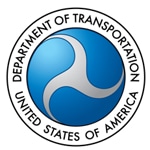
The report was submitted to the Secretary ahead of a two-day NFAC meeting in Washington, D.C., beginning July 15. The NFAC was established by Secretary LaHood in June 2013.
SMART Transportation Division President John Previsich is a member of the committee.
“Our nation’s economic competitiveness depends on a transportation network that can move freight safely and efficiently, especially as we are expected to move double the current amount by 2050,” said Secretary Foxx. “I appreciate the work of the advisory committee – their suggestions will help inform the department’s work improving our country’s future freight system.”
The 81 recommendations made by NFAC, now under review by the department, include suggestions to improve safety and security across the freight rail network, highlight funding needs and challenges, and call for increased streamlining processes and better collection of data and research. The NFAC also proposed exploring ways to improve collaboration for multijurisdictional freight planning, developing goals related to freight safety, and addressing workforce development needs as the Department develops the National Freight Strategic Plan. A copy of the report may be found here: http://www.dot.gov/policy-initiatives/national-freight-advisory-committee/recommendations-us-department-transportations.
Together, these recommendations highlight the need for increased transportation investment and greater certainty to support the kind of research and planning such projects would require. Earlier this year, Secretary Foxx submitted the GROW AMERICA Act for consideration by Congress. This Act will make critical investments to help improve the safe and efficient movement of freight across all modes of transportation – highway, rail, port, and pipeline by providing $10 billion over four years for targeted investments in the nation’s transportation system to improve the movement of freight and by giving shippers, transportation providers, and freight workers a real seat at the table for making investment decisions. The GROW AMERICA Act will also better align planning among the Federal government, states, ports, and local communities to improve decision-making and help improve the U.S.’s long-term competitiveness by taking steps to achieve President Obama’s call to reduce the time it takes to break ground on a new transportation project.
To help DOT promote a safe, economically efficient, and environmentally sustainable freight transportation system, the NFAC provides advice and recommendations to the Secretary on matters related to freight transportation in the United States including (1) implementation of the freight transportation requirements of the Moving Ahead for Progress in the 21st Century Act (MAP-21); (2) establishment of the National Freight Network; (3) development of a National Freight Strategic Plan; (4) development of strategies to help States implement State Freight Advisory Committees and State Freight Plans; (5) development of measures of conditions and performance in freight transportation; (6) development of freight transportation investment, data, and planning tools; and (7) legislative recommendations. More information on the NFAC may be found here: http://www.dot.gov/nfac.

SAN DIEGO, Calif. – John Previsch was elected president of the International Association of Sheet Metal, Air, Rail and Transportation Workers’ Transportation Division June 30, shortly after the opening of the union’s First Transportation Division Convention at the Hilton San Diego Bayfront Hotel.
Previsich, who had been elevated to the position of SMART Transportation Division President Oct. 1, 2013, was challenged for the office by members Mark B. Burrows, Scott Cole and Gary Robison. He received 434 votes of the 485 ballots cast.
Current Alternate National Legislative Director John J. Risch III was elected the Transportation Division’s National Legislative Director and will assume the office Oct. 1. National Legislative Director James A. Stem announced his intention to retire Sept. 30 and did not seek re-election. Risch was opposed by the Transportation Division’s Utah State Legislative Director F. Jay Seegmiller of Local 166 at Salt Lake City. Risch won the election after receiving 285 votes of the 485 valid votes cast.
Incumbent Transportation Division Vice Presidents David B. Wier, John E. Lesniewski, John R. England, Doyle K. Turner and Jeremy R. Ferguson were returned to office by acclamation.
Due to the elimination of the position of SMART Transportation Division assistant president in 2013, Article 21B, Section 35, of the SMART Constitution provides for a successor to the president of the Transportation Division in the event a vacancy occurs between conventions. To provide for such a contingency, delegates elected Lesniewski to that position by acclamation.
Election results for two additional vice president positions were as follows:
Vice President Troy L. Johnson defeated Union Pacific GO 577 General Committee of Adjustment Secretary Charles “Buddy” Piland of Local 1205 at Kingsville, Texas, 270-210.
Santa Monica Municipal Bus Lines GO SMB General Chairperson Adhi S. Reddy defeated incumbent Vice President – Bus Bonnie Morr, 256-228.
In the election for the office of Transportation Division Alternate National Legislative Director, Arizona State Legislative Director Gregory K. Hynes defeated Seegmiller, Louisiana State Legislative Director David S. Duplechain and Virginia State Legislative Director Patrick A. Corp, 274-142-47-22.
July 1 elections:
Federal Railroad Administrator Joe Szabo addressed the delegation on the second day of the First SMART Transportation Division Convention. His remarks can be found here.
At the conclusion of Szabo’s speech, the following elections were held:
Alternate Vice President Bus – East Calvin Studivant was re-elected by acclamation.
Guillermo Rosales of Local 1607 defeated Bonnie Morr, 276-210, for the position of Alternate Vice President Bus – West.
Among seven candidates for six alternate vice president positions, incumbents R.W. “Red” Dare, Danny L. Young, Brent C. Leonard, Mark H. Cook, Chadrick J. Adams and Anthony Simon were returned to office. Candidate Robert J. Keeley received the fewest votes.
Board of Appeals members Dale B. Barnett Jr., Tessa R. Burkle, Dirk A. Sampson, Alvy Hughes and candidate David W. Patenaude were elected by acclamation.
Executive Board members Stephen T. Dawson, Steven C. Mavity, Michael N. Anderson, Robert Resendez Jr. and Phillip J. Craig were elected by acclamation.
John D. Whitaker III was elected to the office of Alternate to the Executive Board by acclamation.
A member of SMART Transportation Division Local 31 at San Jose, Calif., Previsich began his transportation career with Southern Pacific Transportation Company, where he commenced work as a train-service operations employee in San Francisco. He later transferred to engine service and achieved certification as both a railroad conductor and locomotive engineer.
Previsich started doing work as a local union officer in the mid-1980s. Thereafter, he moved into a system-wide position as a general chairperson in the early 1990s, followed by his election to UTU International vice president in 2007. He was re-elected in 2011, elevated to the position of assistant president in 2012 and assumed the responsibilities of the general secretary and treasurer position on Jan. 1, 2013.
Having a special interest in transportation-industry safety issues, Previsich is the SMART Transportation Division representative on the Federal Railroad Administration’s Rail Safety Advisory Committee (RSAC) and has served on numerous subcommittees associated with RSAC. In addition, he is a cabinet-level appointee to the National Freight Advisory Committee, a group that reports directly to the secretary of transportation on MAP-21, a program charged with assisting in the development of administration policy on a national freight plan for the 21st century.
During the course of his career, Previsich has advocated on behalf of his members in mergers and consolidations in the rail and airline industries, 13(c) transactions, divestitures, national and local contract negotiations and numerous arbitrations and mediations, securing and defending collective bargaining agreements on properties large and small.
